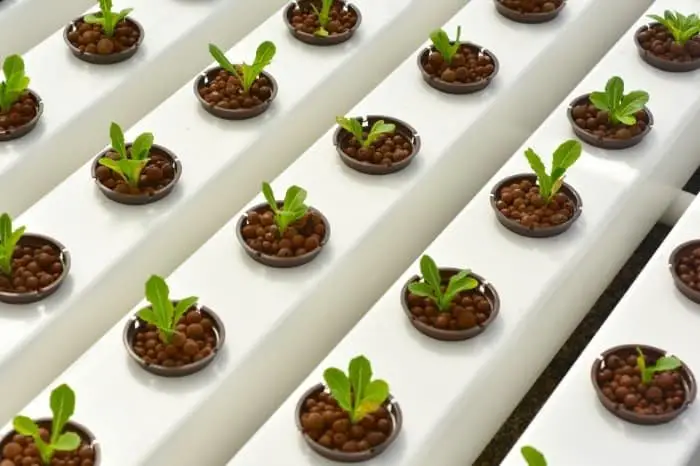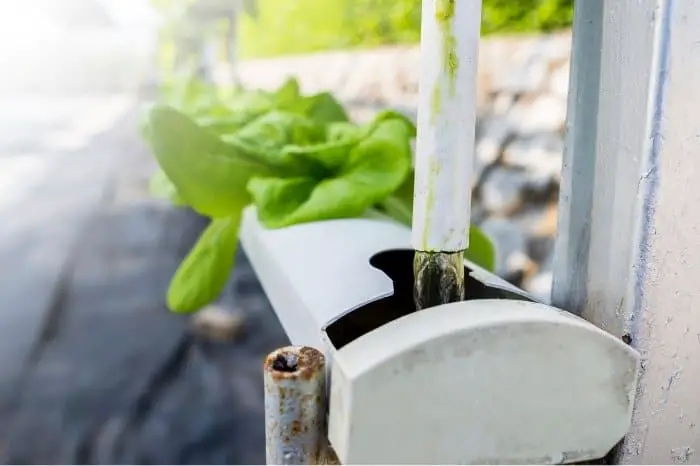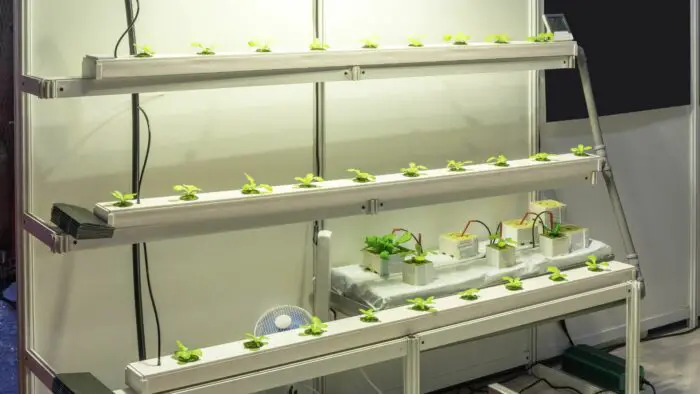Last Updated on March 7, 2023
Do you know how to make a recirculating DWC system? Well, we’ve got you covered here. Recirculating deep water culture also known as RDWC imitates the traditional deep water culture (DWC) by just adding a few modifications.
Deepwater culture is a type of hydroponic system that ensures your plants have constant access to water, nutrient solution, and oxygen all at once. There are also measures put in place for adequate aeration for optimal plant growth.
Setting up your recirculating deep water culture system is pretty easy when you have the right knowledge. This article will go over what you need to know about how to make a recirculating DWC system and many more. So, read on to learn about this.
Recirculating Deep Water Culture
Recirculating the DWC system works just like deep water culture, however, there are a couple of things that will be redesigned. Both RDWC and DWC have their plant roots immersed in nutrient solution and oxygen-filled solution.
The main advantage and difference to recirculating the DWC system are that it’s ideal for large-scaling hydroponic farming. Therefore, several plants can be grown together with the recirculating deep water culture system.
Recirculating deep water culture system works by tubing several buckets or containers. All these containers are connected to a central reservoir.
Building recirculating deep water culture system is not so difficult, even for hydroponics first-time growers and we will show you how.
The major difference between RDWC and DWC is that nutrient solution gets recirculated in recirculating deep water culture. The nutrient solution moves or circulates from one container to the other and finally the reservoir. But in the traditional DWC, the water does not move and it stays in the container.
DIY Recirculating DWC System
Here, we have outlined the process you can follow when it comes to how to make a recirculating DWC system. So let’s begin:
Materials required
Let’s first take a look at the materials required to build your recirculating DWC system:
- 5-gallon dark-colored buckets with lids (with a drilled hole of about 3 inches)
- Net cups of size 3 inches as the drilled hole
- Grow medium (e.g. perlite, Hydroton pebbles, coco coir, and so on)
- Tubing (PVC) for connecting each bucket
- Central reservoir (40 to 55 gallons)
- Air pump and air stone (for oxygenation)
- Inline water pump
- Seeds or seedlings
- Hydroponics nutrient solution
- PH meter and other kits
- PPM meter
Recirculating DWC plans: Procedure
Follow this procedure to learn how to make a recirculating DWC system:
1. Reservoir
Choose the reservoir where you will be storing your hydroponics nutrient. The inline pump should be set inside your reservoir. Also, an air pump and air stone should be in your reservoir.
2. Set up your buckets or containers
Determine the number of buckets or containers you will be using for your recirculating DWC system. The buckets should have lids where you will make a cutting for your net pot to fit in. Inside your net pots, fill them with your preferred growing medium and this is where your plant will be.
Also, holes should be cut on each side of your bucket and connected to your pipe. This pipe will connect to other buckets and back or down to your reservoir. Each bucket or container must have its air stones.
3. Position your plant
You can grow your seeds indoors with net pots that contain a growing medium and transplant them into your RDWC system. You can grow about 2 or 3 plants in each container. Note that your net pot should have a wide mesh at the base so that the plant root can touch the nutrient water container.

4. PH balancing
The next thing is to balance the pH. Different plants require different pH ranges to grow adequately. However, the general pH range for plants is around 5.5 to 6.5.
So, your recirculating deep water culture system is ready to run. If later on, you decide to add extra containers or buckets, you must also add more nutrient solutions to the reservoir. This is to ensure each plant gets the appropriate amount of nutrients to grow optimally.
We also recommend you have 3 plants maximum for each container so your plants can get a sufficient amount of nutrients and oxygen. Having more than 3 plants may increase the risk of nutrient and oxygen competition which can diminish each plant’s survival rate.
How Does RDWC Works?
Recirculating DWC systems always have their plant root submerged in water. But usually, plant roots don’t always like their roots immersed in water; especially all day as they can suffocate. But why is it different in the deep water culture system? Well, let’s find out.
We have 3 major components and keys to the RDWC system and they are:
- Oxygen: The most essential part of both deep water and recirculating deep water culture systems is oxygenation. This is because we have plant roots always immersed in water. Therefore, you need to provide all means of oxygenation so your plant does not choke. So, the use of air pumps and air stones solves this air circulation problem.
- Water: We can see that water is a great factor in the structure of the RDWC system. Plants are always being fed oxygen-rich water thereby taking away the need of watering your plants constantly as you would have in traditional soil.

- Nutrients: Another great component that makes your RDWC system work perfectly is the hydroponics nutrient supplied to your plants. The nutrient originates or comes from the major reservoir and passes along the pipes to reach each connected container.
RDWC and DWC System: Major Difference
So, in the recirculating deep water culture system, the nutrient-filled water is reused and is not drained. However, the traditional deep water culture nutrient solution always remains in the container. Recirculating DWC also allows for large scaling, unlike the traditional deep water culture system.
Bucket Hydroponic System: How to Make Your Own
You may be wondering how to make your own 5-gallon hydroponic bucket system. If this is the case, then look no further! For this guide, you’ll need the following equipment:
- 5-gallon bucket
- net bucket lid
- water pump (ideally, aquarium)
- air hose
- check valve
- clay pebbles
- air stones (at least 6 inches in size)
Now all you need to do is:
- The first thing you need to do is cut a small amount of your air hose (around a few inches or so). To one end, attach to your pump. Now you’re going to attach your air hose to the check valve. Ensure that air can run freely through your valve before moving on to the next step.
- With the rest of your hose, cut a piece that is long enough to reach both the check valve and the bottom of your bucket. Try not to make the space between the two more than around 5ft. If the space between the two is too long, it won’t work as efficiently as it should.
- Grab your net bucket lid and drill a hole. The hole should be big enough for your hose to go through. Then add your air stone, as well as the lid, and then connect to your air hose.
- Now you’ll need to add your clay pebbles to the net pot, as well as whatever it is you’re planting. Then water and add nutrients. It is that simple!
Best 2 Bucket DWC System
When it comes to a 2 bucket DWC system, there are many options you can choose from. But the one from PA Hydroponics is my personal favorite. It comes already drilled and ready to assemble, with all the components you need. It costs around $80 and includes two buckets, 2 bucket lids, 1 bag of clay rocks, an air pump, 2 air stones, 10ft of the airline, 2 water indicator kits, and 4 starter plugs. You can also choose to drill it yourself, which will save you around $15.
Best Water Pump For Hydroponic Systems
The water pump is very important to your hydroponic system, so you’ll need to invest in a good one. If you’re looking for a good one on a budget, I would choose the VicTsing 80 GPH Submersible Water Pump.
It holds less than 20 gallons and weighs just under 6oz. It has an adjustable flow and a cord length of just under 6 feet. It also comes with two adapters: 1/2″ and 3/8″. It’s popular among growers because of its unbeatable price. It may be small but it definitely does the job.
Another amazing pump is the Hydrofarm Active Aqua 400 GPH Submersible Water Pump. It can hold up to 40 gallons and weighs just under 3lb. It has an adjustable flow and comes with two tubing fittings: 1/2″ and 3/4″. This is much bigger than the first option, and also much pricier; so it may not be best if you’re a beginner to hydroponic growing.
Additional Say on How to Make a Recirculating DWC System
Even though you can simply purchase already made recirculating DWC online, you can also build your own as well. Just follow our outlined procedure on how to build a recirculating DWC system. Do you have any tips on tricks when it comes to making a recirculating DWC system? If so, please feel free to let us know in the comments below. And remember, sharing is caring!
FAQs
How do you build a recirculating hydroponic system?
There are two main options when it comes to building a recirculating hydroponic system. You can either build a completely self-contained system or you can have a water system that is connected to your home’s existing plumbing. When it comes to a completely self-contained system, there are many different options when it comes to building your own hydroponic system. If you want to save some money, you can buy a pre-made hydroponic unit from a local garden supply store.
You can use a pump to recirculate the water through the system. The water should be filtered before entering the pump, and also after leaving it (if using an air-lift pump). If the pump is attached to a drain, you'll need to make sure the drain is not clogged with debris or any other material that would cause blockage. You could also use a sump pump with a hose to pump the water back into the tank.
Hydroponics is a term used to describe the growing of plants in water using a nutrient rich solution. It is a form of cultivation that can be used to grow vegetables and herbs indoors in controlled environments.
The advantages of this method are the ability to produce large quantities of high quality vegetables and herbs in an indoor environment. The major disadvantage is that it is more labour intensive than traditional methods. I’m not talking about the time it takes to clean up after harvesting, but the initial setup and maintenance of the system.
How does a recirculating hydroponic system work?
A recirculating hydroponic system is a method of growing plants that involves using water and nutrients to nourish plants in a closed system. It is a very efficient way of growing plants, and can be used to grow a wide variety of plants.
The water is pumped into the grow room, and then circulated through a nutrient solution by means of a pump. The pump draws the solution from the reservoir, and pushes it through a series of filters and pumps that carry the solution to where it can be distributed evenly to the plants.
A recirculating hydroponic system is one of the most effective methods for growing healthy plants indoors. It requires no soil, making it perfect for people who have allergies or other concerns about soil-based plants. The nutrient solution is constantly recirculated, providing a constant supply of fresh nutrients and oxygen to the roots. The only thing that goes out of the system is water. The process The key to a successful recirculating hydroponic system is the design of the system. A simple setup will not work, and will need to be modified or replaced over time. This is because the roots of the plant grow and develop differently as they grow. A large number of plants will also require a different system. As a general rule, the size of the system should be proportional to the space you have available.

Eunice is an enthusiastic gardener with a passion for growing beautiful flowers. She loves nothing more than spending time in her garden, tending to her plants and enjoying the outdoors. Eunice has been gardening for over 15 years and has developed a unique style of landscaping that is both practical and aesthetically pleasing. She is especially fond of growing roses and enjoys experimenting with different varieties and colors. Eunice takes great pride in her garden and often shares the fruits of her labor with friends and family. In her spare time, she enjoys reading gardening magazines and attending local horticulture events. Eunice is passionate about her hobby and is always eager to share her knowledge and experience with others.


